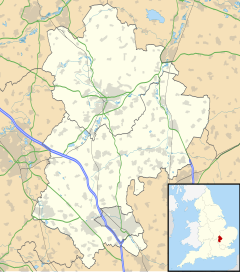Silsoe
| Silsoe | |
|---|---|
 Silsoe village sign 2000 Millennium Year |
|
| Silsoe shown within Bedfordshire | |
| Population | 1,729 (2001 Census) 1,791 (2011 Census) |
| OS grid reference | TL082354 |
| • London | 39 miles (63 km) |
| Civil parish |
|
| Unitary authority | |
| Ceremonial county | |
| Region | |
| Country | England |
| Sovereign state | United Kingdom |
| Post town | BEDFORD |
| Postcode district | MK45 |
| Dialling code | 01525 |
| Police | Bedfordshire |
| Fire | Bedfordshire and Luton |
| Ambulance | East of England |
| EU Parliament | East of England |
| UK Parliament | |
Silsoe is a village and civil parish in Bedfordshire, England. The village used to be on the main A6 road but a bypass around the village was opened in 1981 at a cost of £1.6m.
The village name is derived from the Danish word 'hoh', in "Sifels hoh", meaning "Sifel's hill". The Danes were thought to have been the earliest settlers here. The Domesday Book (1086 – Siuuilessou or Sewilessou) records two manors, the larger held by Hugh of Walter, brother of Saher, and this later became the manor of Wrest. A smaller manor, believed to be that of Newbury, was owned by a concubine of Nigel d'Aubigny. The first market was held here weekly on Tuesdays and annual fair on 1 May from 1318.
A Latinized form of the village name may be seen as "Sevelesho", in a legal record of 1430, where the defendants William Butte, yeoman & William Clerk, husbandman lived.
By 1563 there were 21 families living in Silsoe. The village growth was largely influenced by the needs of the Wrest Park estate and most of the inhabitants were servants, gardeners, stable hands and blacksmiths who lived in thatched and terrace cottages some of which still exist today. There was also a baker, who supplied Wrest House, and in the roof of the old bakehouse off the High Street, the oven ventilation can still be seen. From 1715 an annual fair was held on 10 September and a weekly market on Wednesdays. By the mid-19th century a number of trades were present in the village. There was a butcher, a milkman, cobbler, draper, builder and a grocer.
The Wrest Estate, in turn, provided the village with a church – St James's, a school and a row of almhouses, so sited that a row of cottages was hidden from the gentry's view as they drove from the Park to the church in nearby Flitton. Silsoe's position on a main road to London and halfway between Bedford and Luton made it a favourite halt for drovers and travellers stopping at the George coaching inn (first mentioned in 1624) on the High Street. Silsoe had many inns including The White Hart, The Ragged Staff, Duke of Kent's Arms, The Bell, The Battle of Alma (or known as The Mouse's Hole in West End Road), Lord Nelson (Newbury Lane). Now only the George and Star and Garter in the High Street remain. During the First World War Wrest House was used as a military hospital until 1916 when the house was damaged by fire. Lady Lucas, the last member of the de Grey dynasty, sold the House and estate before an auction that was to have been held at the Mart, Tokenhouse Yard, London EC2 on 17 July 1917.
...
Wikipedia

